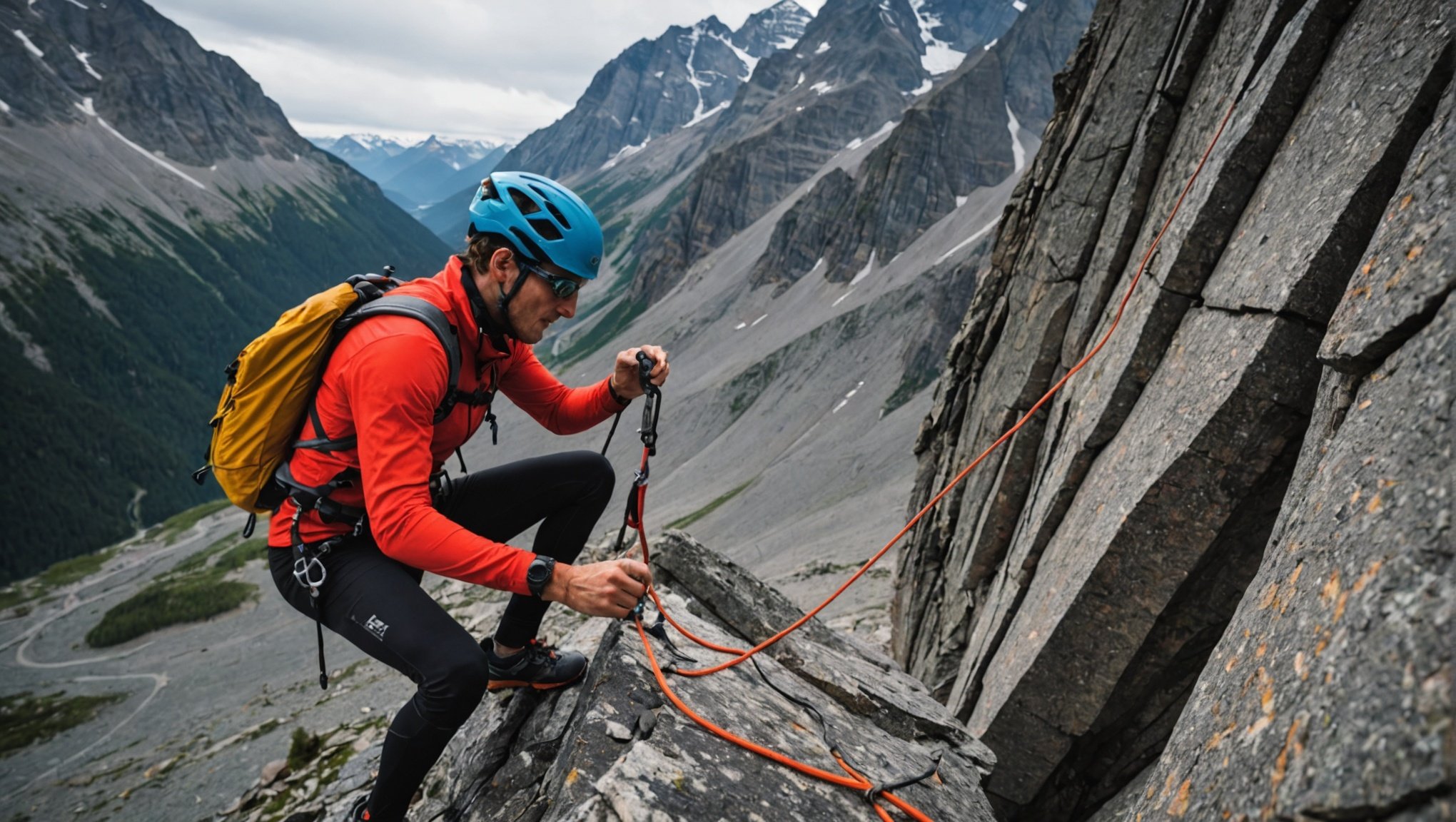Breathing Techniques for Enhanced Oxygen Absorption
Achieving peak performance during climbs relies heavily on effective breathing exercises. These exercises are essential for climbers looking to optimize their oxygen efficiency and maintain stamina at high altitudes. Understanding and incorporating these exercises into your routine can significantly improve your climbing experience.
Diaphragmatic breathing, also known as belly breathing, plays a pivotal role in oxygen efficiency. This technique involves engaging the diaphragm by inhaling deeply through the nose, allowing the stomach to expand instead of the chest. This method increases lung capacity and ensures a more extensive oxygen exchange, critical for high-altitude climbs where oxygen levels are reduced.
Have you seen this : Essential Stretches Every Golfer Needs to Avoid Shoulder Injuries
Maintaining optimal breathing patterns can be challenging during strenuous climbs. To achieve this, climbers should practice regular respiratory exercises such as paced breathing and rhythmic breathing patterns. Pacing your breath helps in conserving energy, while rhythmic breathing aligns breath with movement, reducing fatigue.
For increased effectiveness, combine these techniques:
Also to read : Enhancing Focus and Concentration: Top Strategies for Competitive Chess Players
- Practice deep breathing before climbs to oxygenate your system.
- Use consistent patterns of inhalation and exhalation during activity.
- Integrate breathing exercises into daily routines for sustained benefits.
By focusing on these techniques, climbers can enhance their oxygen absorption, boosting both endurance and performance.
Physical Conditioning Strategies
Building a solid foundation of cardiovascular fitness is crucial for optimal oxygen utilization in climbing. It enhances the body’s capability to deliver oxygen to the muscles, increasing stamina and reducing fatigue during long climbing sessions. Activities such as running, cycling, and swimming are excellent options to boost cardiovascular endurance. They not only improve heart health but also condition muscles for better climbing performance.
Strength training is another essential component of a climber’s regimen. Incorporating exercises like pull-ups, deadlifts, and planks can significantly increase upper body and core strength, which are critical for maintaining grip and balance on challenging routes. These exercises target key muscle groups needed for lifting and stabilizing the body during climbs, providing the power necessary for effective movement and precision.
For enhancing endurance, activities like hiking with a weighted backpack or using a rowing machine can be particularly beneficial. These exercises build muscular endurance, allowing climbers to sustain their strength and technique over extended periods. A combination of cardiovascular fitness, targeted strength training, and dedicated endurance exercises ensures climbers can tackle their climbing goals confidently and efficiently. By tailoring workouts to these key areas, climbers can amplify their physical capabilities and better manage the demands of climbing.
Nutrition and Hydration for Climbers
Climbers venturing into high altitudes face unique nutritional demands. The reduced oxygen levels necessitate a balanced diet rich in oxygen-enhancing foods. Favoured choices include leafy greens like spinach and kale, along with beetroot, known for its ability to improve oxygen uptake. Such “oxygen-rich foods” are essential for sustaining energy and maintaining performance when air is thin.
Proper hydration strategies are equally crucial. At high altitudes, climbers lose moisture quicker due to increased respiration. Aiming for consistent water intake helps prevent dehydration, which can hinder acclimatization and reduce climbing efficiency. In addition to plain water, it may be beneficial to include electrolyte-enhanced drinks to replenish vital salts lost through sweat, ensuring the body’s systems remain balanced.
Nutritional requirements for climbers are not one-size-fits-all but should be tailored to support energy expenditure and enhance overall endurance. Carbohydrate-rich foods are particularly recommended, providing the necessary fuel for arduous ascents. Proteins also serve a vital role, aiding in muscle repair, which is crucial after long days of physical exertion. By integrating these targeted dietary choices, climbers can optimize their ability to meet the challenges presented by high-altitude climbing.
Acclimatization Techniques
Embarking on high-altitude adventures requires a keen understanding of the acclimatization process. It is crucial to adopt strategies that aid in altitude sickness prevention and ensure a successful climbing experience. One fundamental step is to allow for a gradual ascent. Ascending slowly enables the body to adjust incrementally, reducing the risk of altitude-induced ailments.
To reinforce this approach, incorporating rest days into the itinerary is vital. These days offer the body time to produce more red blood cells, enhancing oxygen delivery throughout the system. It is recommended to spend at least one rest day every 1,000 metres gained, providing adequate time to acclimate. Additionally, “climbing high, sleeping low” is an effective tactic where climbers venture to higher altitudes during the day before descending to lower elevations for rest.
Another critical aspect of the acclimatization process is maintaining hydration. Consuming sufficient fluids aids in circulation and reduces symptoms of altitude sickness, promoting overall well-being. Nutrient-rich meals support energy levels and acclimatization, ensuring the body has the necessary resources to adapt. By adhering to these acclimatization techniques, climbers can safely navigate their ascent and enjoy their high-altitude endeavours with minimal risks.
Gear and Equipment for Optimal Performance
When tackling high altitudes, having the right climbing gear is crucial. Essentials like durable ropes, harnesses, and oxygen delivery systems are critical for reaching new heights safely. Without these, climbers face increased risks, including severe weather conditions or unexpected terrain challenges.
Supplemental oxygen delivery systems are a lifeline for those venturing into thin air. They enhance endurance and ensure climbers can breathe easily in low-oxygen environments. These systems are often used above certain altitudes to maintain performance and increase survival chances, especially when pressure and oxygen levels drop dramatically.
Equally important is the safety equipment. Helmets, ice axes, and crampons ensure that climbers can tackle icy patches and protect themselves if they slip or fall. Harnesses and robust carabiners secure climbers to their routes, providing much-needed support when the stakes are high.
Beyond survival, optimal gear enhances performance, allowing climbers to focus on technique rather than worrying about potential dangers. By investing in the right equipment, climbers not only improve their safety but also maximise their experience and adventure, enabling them to push limits with confidence and security.
Expert Opinions and Real-Life Testimonials
Climbing enthusiasts often seek expert insights to elevate their alpine experiences. Experienced climbers universally emphasise the importance of understanding oxygen absorption at high altitudes. This knowledge is indispensable for successful ascents. Oxygen levels decrease as one climbs higher, making acclimatisation crucial. Climbers often practice this by gradually increasing their elevation to allow their bodies to absorb oxygen more efficiently.
Seasoned mountaineers advocate for the “climb high, sleep low” method, a best practice widely endorsed in the climbing community. By climbing to a higher altitude during the day and descending to sleep, climbers adapt more safely. This technique is lauded in numerous testimonials for reducing altitude sickness symptoms.
Additionally, expert insights recommend regular hydration and balanced nutrition to support oxygen absorption. Real-life experiences accentuate the significance of listening to one’s body signals. Testimonials from successful climbers often highlight moments when respecting these signals helped them push through challenging climbs. These shared experiences offer climbing enthusiasts valuable lessons, transforming theoretical knowledge into practical wisdom.
Harnessing these expert opinions and real-life testimonials can enhance one’s climbing journey, rendering it not only more successful but also far safer.






